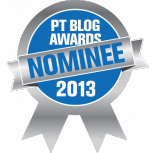 A few days ago, I posted about the perpetuation of spinal myths in common mass media markets such as television. It just so happens that both video clips that I shared in the article involved chiropractors.
A few days ago, I posted about the perpetuation of spinal myths in common mass media markets such as television. It just so happens that both video clips that I shared in the article involved chiropractors.
There are plenty of physicians and physical therapists out there that are quick to point their fingers at what chiropractors do. Many that are pointing fingers at chiropractors about practice patterns and excessive numbers of visits are the same ones applying ultrasound 3 times per week, using yellow theraband forever, and manipulating because they can – not because it is necessary. As the saying goes, when you point a finger, three point back at you … and who knows where the thumb stands on the issue.
With that said, I would suggest that the chiropractic profession has provided three valuable lessons that physical therapists could benefit from learning.
1. Professional autonomy is a united front. Sure, there are disagreements about treatment methods and the like, but chiropractors as a whole tend to provide a united front when it comes to professional autonomy and what that looks like. I rarely hear debates of whether they should or shouldn’t have autonomy. But with that said, I cannot believe the number of times that I have been in a large group of physical therapists that simply won’t agree on what professional autonomy is. Maybe I am wrong, but chiropractors appear to have it hard-wired into their professional-training DNA.
2. Major media marketing buzz = setting a standard with patients. Look at the recent episodes of Dr. Oz and Dr. Phil. Regardless of the information presented, they created a true media buzz about the profession. The average person views that as instant credibility. Sure, we can talk about how the literature supports physical therapy for back pain and all sorts of issues like that, but people will only realize when it appears on Oprah or something similar. If it’s hot and exciting, and front-and-center in the mass media, the referrals will go up and the demand will too. It will also provide patients with more reason to push aggressively for direct access to care.
3. The chiropractic profession took on the AMA - and won. It would be of value for all physical therapists to look at the legal battles waged by chiropractors against the American Medical Association. Take, for example, Wilk v. American Medical Association (1976), a federal anti-trust lawsuit. There are some very sordid tales to be found. In 1987, after 11 years of legal wrangling, the court held that the AMA and its members violated the Sherman Act by unlawfully conspiring to restrain trade.
Physical therapists, for all intents and purposes, are now the only health care provider that requires a gatekeeper’s referral in order to practice their trade fully and freely to the extent of their professional training. But does the gatekeeper model – otherwise known as a legalized monopoly – effectively become a restraint of trade issue for physical therapists? As I have mentioned in prior articles, just take a look at the “Scope Of Practice Partnership” and you make the call. The AMA continues to call it a “patient safety” issue, but they said that about the chiropractors as well. The precedence, as they say, has been set.
In the meantime, physical therapists continue to stand firmly in the middle of the road while being nice and “building relationships”. It might be time to learn a few of those lessons.
Photo credits: umjanedoan
 "Running Injuries: Etiology And Recovery- Based Treatment" (co-author Bridget Clark, PT) appears in the third edition and fourth editions of "Clinical Orthopaedic Rehabilitation: A Team Approach" by Charles Giangarra, MD and Robert C. Manske, PT.
"Running Injuries: Etiology And Recovery- Based Treatment" (co-author Bridget Clark, PT) appears in the third edition and fourth editions of "Clinical Orthopaedic Rehabilitation: A Team Approach" by Charles Giangarra, MD and Robert C. Manske, PT.
 Allan Besselink, PT, DPT, Ph.D., Dip.MDT has a unique voice in the world of sports, education, and health care. Read more about Allan here.
Allan Besselink, PT, DPT, Ph.D., Dip.MDT has a unique voice in the world of sports, education, and health care. Read more about Allan here.
 Top 5 finalist in three categories: "Best Overall Blog", "Best PT Blog" and "Best Advocacy Blog".
Top 5 finalist in three categories: "Best Overall Blog", "Best PT Blog" and "Best Advocacy Blog".